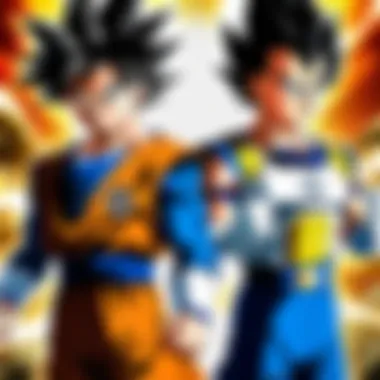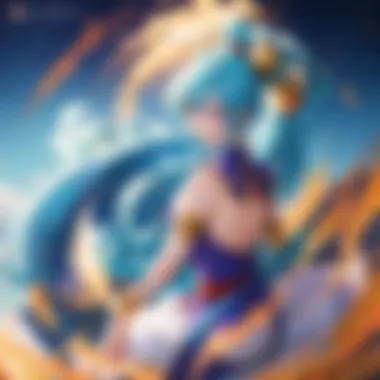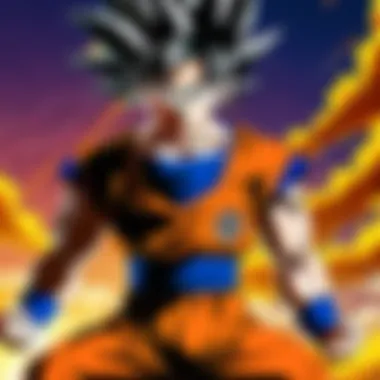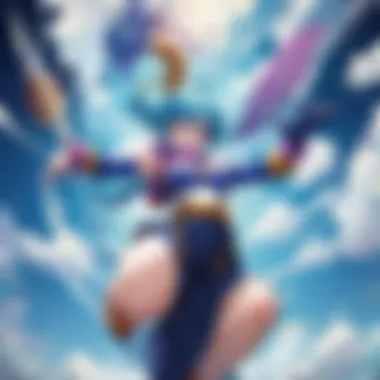In-Depth Analysis of Dragon Ball Super: Characters and Themes


Intro
The world of anime is vast and diverse, featuring series that captivate audiences with intricate plots and deep character development. One such series is Dragon Ball Super. Since its debut, it has garnered a significant following and expanded the Dragon Ball universe created by Akira Toriyama. This exploration aims to dissect the themes, characters, and impact of this series.
With a narrative steeped in action, camaraderie, and resolution, Dragon Ball Super invites the audience into a realm where themes of perseverance and friendship are consistently explored. The series not only showcases the evolution of beloved characters but also introduces new ones, enriching the established lore. By examining these elements, we can better understand the cultural significance of Dragon Ball Super within the contemporary anime landscape.
Anime Series Overview
Brief Synopsis of the Anime Series
Dragon Ball Super follows Goku and his companions after the defeat of Majin Buu. The peace is threatened by the arrival of powerful foes, including gods and interdimensional fighters. Each saga introduces formidable characters, culminating in epic battles that challenge not only the strength of the heroes but also their beliefs and values. Themes such as friendship and growth are central as our heroes adapt to new challenges.
Intro to Main Characters
In this expansive universe, the character development is paramount. Goku, always eager for challenge, strives to surpass his limits. His counterpart, Vegeta, embodies pride and determination, often acting as Goku’s rival. Other characters, like Gohan and Piccolo, experience substantial growth. Gohan balances family and strength, reflecting a mature outlook, while Piccolo showcases unwavering loyalty to his friends.
Discussion on Animation Style, Soundtrack, and Notable Episodes
The animation style in Dragon Ball Super, while a continuation of its predecessor's look, incorporates modern techniques that enhance fluidity during action scenes. The soundtrack, composed by Nakashima Yuusuke, complements the narrative with exhilarating themes that elevate emotional moments. Notable episodes, such as the Tournament of Power, highlight not only the visual appeal but also the compelling storytelling that engages viewers.
Character Analysis
Detailed Breakdown of Main Characters
- Goku: A warrior eager for enlightenment. His personality is defined by optimism and determination.
- Vegeta: Driven by a need for strength, he is complex with deep ties to family and heritage.
- Gohan: A mix of intelligence and combat skills represents growth toward maturity.
- Piccolo: The loyal guardian endears himself to both allies and fans with his wisdom and strength.
Character Relationships and Dynamics
Goku and Vegeta's rivalry signifies both challenge and growth. Their dynamics mirror that of mentorship and competition. Meanwhile, Gohan's relationship with Piccolo showcases a father-son bond that impacts both their journeys throughout the series.
Impact of Characters on Overall Storyline and Fan Theories
Characters shape the narrative, driving the plot forward through their decisions and conflicts. Fan theories often arise around the potential developments of these characters, reflecting the audience's investment in their arcs.
Genre Spotlight
Prologue to the Specific Genre
Dragon Ball Super resides in the shonen genre, primarily targeted towards younger audiences, yet it appeals to all ages. Action, adventure, and fantasy blend together, often with moral lessons woven throughout.
History and Evolution of the Genre in the Anime Industry
Shonen anime has a rich history, evolving from early works to include a diverse array of themes and character types. The genre has shifted from simplistic narratives to intricate stories, with Dragon Ball Super representing this progression.
Notable Series Within the Genre
Notable series such as Naruto and One Piece share similar themes of adventure and friendship, creating a dynamic landscape where Dragon Ball Super finds its place. While each series possesses unique traits, they often explore common themes of loyalty and resilience.
Behind-the-Scenes Insights
Exploration of the Production Process


The production of Dragon Ball Super involved detailed planning and a dedication to maintaining the series' legacy. Revamping visual effects and story arcs required collaboration among artists, animators, and writers, ensuring fidelity while also innovating.
Challenges Faced During Production
Challenges included reconciling the expectations of long-time fans with the need to introduce new elements. The balance of nostalgia and fresh content was critical.
Success Factors of the Anime Series
Successful adaptation and storytelling have contributed to the series' popularity. Engaging scriptwriting, coupled with impressive animation, has consistently attracted viewership and reinvigorated interest among the fanbase.
"Dragon Ball Super is not merely a continuation; it’s an evolution of a cherished narrative that resonates with diverse audiences."
Through this exploration, it becomes evident that Dragon Ball Super possesses depth that warrants discussion and admiration. It builds upon the legacy of its predecessors and continues to influence the future of anime.
Intro to Dragon Ball Super
The arrival of Dragon Ball Super marked a significant chapter in the enduring saga of the Dragon Ball franchise. Dragon Ball Super is crucial not only for its vibrant storytelling but also for its role in reviving the popularity of anime and manga globally. This section serves as a foundation, setting the stage for a deeper exploration of its narrative intricacies, character dynamics, and the broader themes that resonate within it.
Overview of the Dragon Ball Franchise
The Dragon Ball franchise, created by Akira Toriyama, has long been a cornerstone of the anime and manga world. It began in 1984 with a simple, adventure-driven narrative centering around Goku. Over the decades, the series evolved significantly, transitioning from martial arts narratives to epic cosmic battles involving gods and universes. This extensive development laid the groundwork for Dragon Ball Super, which continues to expand the mythology and offers fresh narratives for both enthusiasts and newcomers.
Release and Reception of Dragon Ball Super
Dragon Ball Super premiered in July 2015 and was well-received by fans and critics alike. It introduced new characters, such as Beerus and Whis, who played pivotal roles in the storyline. The animation and storytelling attracted both praise and scrutiny, with some long-time fans welcoming the continuation, while others critiqued deviations from the original style. Despite mixed reviews, the series quickly developed a dedicated fanbase. Its ability to bridge nostalgia for Dragon Ball Z while providing fresh content demonstrates its unique position within contemporary anime.
"With Dragon Ball Super, the essence of Goku's journey continues, reflecting deeper themes while maintaining the humor and excitement that fans cherish."
The transition from the original series to Dragon Ball Super marked a revival, affirming the franchise's prominence in the anime landscape. Its success has significant implications for how the series might evolve in future iterations.
Narrative Structure
The narrative structure of Dragon Ball Super plays a vital role in understanding its storytelling depth and character evolution. This structure anchors the series, allowing both seasoned fans and newcomers to seamlessly navigate its complex universe. It integrates various arcs that contribute uniquely to the overarching narrative. The careful arrangement of these arcs serves to enhance character development while introducing new themes that resonate with audiences. This narrative design creates a cohesive experience, ensuring that each story element serves a purpose in the series’ larger framework.
Setting and Timeline
Dragon Ball Super is set in a timeline that follows the events of Dragon Ball Z, specifically after the defeat of Majin Buu. The series introduces new worlds and characters, expanding the Dragon Ball universe beyond its previous constraints. The timeline is carefully plotted, with key events taking place after the original series while also weaving in flashbacks and alternate timelines, such as those seen in the Future Trunks Saga. This setting allows the narrative to explore complex themes, like the clash of universes and the consequences of time travel. As such, fans are presented with a rich tapestry that is both familiar yet fresh.
Major Arcs Explained
The major arcs of Dragon Ball Super each bring different significant elements to the narrative, creating a far-reaching impact on characters and themes.
Battle of Gods
The Battle of Gods arc introduces Beerus, the God of Destruction, and marked a critical turning point in the series. This arc emphasizes the concept of power in a fresh way by showcasing the existence of deities beyond the traditional character hierarchy. The Battle of Gods successfully raises the stakes, setting the tone for future confrontations and character developments. Its defining characteristic lies in the struggle for survival against a god-like antagonist, making it a preferred choice for analysis. The anime choices in storytelling, such as Goku’s transformation and the exploration of divine beings, illuminate the benefits of this arc. These elements highlight Goku’s ongoing journey to reach new heights while facing overwhelming challenges.
Future Trunks Saga
The Future Trunks Saga delves into darker themes, focusing on the ramifications of time travel. It reintroduces the character of Trunks, who fights to save his dystopian future from Goku Black. This arc provides a narrative rich in emotional depth and tension, leading to a significant evolution of Trunks as a character. Its key characteristic is the exploration of an alternate future where the consequences of past decisions manifest in catastrophic ways. The depth of storytelling and character development in this saga renders it a powerful addition to the overall narrative. It allows fans to reflect on themes of determination and sacrifice, resonating with the audience on multiple levels.
Universe Survival Saga
The Universe Survival Saga brings a high-stakes tournament format that challenges numerous characters from various universes. This arc emphasizes the importance of teamwork and unity against a common threat. The key characteristic of this saga is its expansive cast and the introduction of formidable new characters, including Jiren. The diversity of fighters makes this arc particularly beneficial for discussion, as each character brings different philosophies and motivations. The unique feature of this arc lies in its portrayal of multiversal interactions and the concept of fighting not just for personal glory but for the survival of one’s universe. The stakes levied here provoke thought about friendship and competition, cementing its relevance in the larger narrative.


In essence, the structure of Dragon Ball Super, marked by these major arcs, enriches the storytelling experience. The integration of new characters and themes allows a deeper exploration of familiar narratives, giving fans more substantial content to engage with.
Character Development
Character development is central to any narrative, especially in a series as rich and intricate as Dragon Ball Super. In this series, character arcs are not merely a collection of events but represent profound personal growth, moral dilemmas, and the intricacies of relationships. The depth of the characters engages audiences by allowing them to connect with voices that echo their own struggles and aspirations.
Each character’s journey reinforces the themes of friendship, strength, and courage. As characters face challenges, they evolve, which reflects the viewers’ own growth. This however isn't just about power levels or fighting techniques; it encapsulates emotional and psychological transformations that resonate deeply. In a broader context, the development of characters enriches the entire narrative, creating layers of meaning that are both entertaining and thought-provoking.
Goku: A Continual Journey
Goku remains the face of the franchise, embodying the ideal hero. His continual journey illustrates his aspiration to transcend limits. This character develops through engagement with formidable enemies and the experiences gained from battles. Unlike many protagonists, Goku does not primarily seek victory but aims for personal growth and understanding.
This commitment to self-improvement displays a nuanced portrayal of ambition. Despite his power, Goku shows humility, often considering others' perspectives. Such traits serve to inspire. They remind viewers of the importance of resilience and dedication.
Vegeta's Transformation
Vegeta’s arc is marked by transformation. Initially portrayed as a villain, his evolution into a hero is remarkable. Vegeta symbolizes the struggle between pride and the acceptance of help. Throughout Dragon Ball Super, he evolves from a ruthless warrior to a protective father and ally. His pride initially defines him, but his interactions with Goku and Bulma help him discover the value of companionship.
His relentless drive to improve showcases an intricate, multi-dimensional character. One notable aspect of Vegeta’s development is his struggle with his past. He learns to balance his fierce nature with compassion. This aspect makes him a relatable character. Many individuals grapple with identity and transformation, precisely what makes Vegeta's story so impactful.
The Rise of New Characters
Beerus
Beerus, the God of Destruction, introduces a new tier of power and responsibility. His character adds complexity to the narrative. His key characteristic is that he balances laziness with immense strength. This juxtaposition makes him a compelling figure in the series. Beerus' role emphasizes the concept that strength comes with duties, not just abilities.
Moreover, his unique feature is the menacing yet whimsical nature that complicates motivations of other characters. He challenges existing norms, for example how typically strong characters exhibit unshakeable pride. The introduction of Beerus showcases the intricate layers of the Dragon Ball universe that challenge traditional hero-villain dynamics and adds richness to the storyline.
Whis
Whis, Beerus' attendant, further enhances the narrative with his calm demeanor and sage wisdom. He represents a mentor figure that provides guidance to Goku and Vegeta. Whis is characterized by his powerful yet serene presence. Unlike many other characters, he possesses unique abilities that make him intriguing. His interactions often highlight the importance of strategy over brute force.
In a series often filled with aggressive confrontations, Whis stands out by reinforcing the value of patience and intellect. His unique feature is his time-manipulating ability, which opens discussions about fate and choices. This adds another layer of complexity to the Dragon Ball Super narrative.
Jiren
Jiren serves as a significant antagonist in the Universe Survival Saga. His character is built around strength and a strict moral code. He is defined by his tragic past, which influences his actions. Jiren's key characteristic is the concept of solitude. His journey emphasizes the struggle between personal loss and the desire for justice.
This aspect resonates deeply with viewers, making him a relatable figure despite being an adversary. Furthermore, Jiren's unique feature is his overwhelming strength which forces Goku and his friends to push their limits. He serves not just as a foe but also as a catalyst for character development, allowing Goku and Vegeta to confront their own beliefs about strength and companionship.
Themes and Motifs
In the realm of anime, Themes and Motifs serve as a backbone to narrative depth and character progression. Within Dragon Ball Super, these elements are not merely decorative but critical in guiding the viewer's understanding of the characters' journeys and the series' philosophical underpinnings. By exploring themes such as friendship, rivalry, the concept of strength, and courage against adversity, the narrative becomes a rich tapestry that resonates deeply with viewers.
The significance is manifold. Firstly, these themes help in establishing a connection between the audience and the characters. This connection becomes essential for emotional investment in the storyline. Moreover, the recurring motifs highlight societal values, encouraging reflection on individual experiences and relationships. In essence, the thematic exploration in Dragon Ball Super not only entertains but invites contemplation and engagement with broader life lessons.
Friendship and Rivalry
The dynamics of friendship and rivalry in Dragon Ball Super add layers to character interactions. Goku and Vegeta exemplify this duality perfectly. Their relationship showcases the competitive spirit that drives them both, serving as a catalyst for growth. The rivalry compels them to push their limits, creating a compelling narrative tension.
Friendship, on the other hand, manifests in the support characters provide. For instance, the bonds formed between the Z fighters create a supportive environment that fosters resilience. When characters face overwhelming odds, the strength derived from friendship becomes pivotal.


Quote: "Friendship is not just a bond; it is a source of strength that shapes heroes."
This theme not only emphasizes personal development but also illustrates the importance of community and unity in the face of challenges. The balance of rivalry and friendship encourages viewers to recognize that competition can coexist with camaraderie, allowing for a richer understanding of interpersonal dynamics.
The Concept of Strength
Strength in Dragon Ball Super transcends the physical prowess typically associated with fighters. It encompasses inner strength, resilience, and character. This multi-faceted approach to strength is evident in characters' growth arcs, where they overcome personal fears and limitations.
For instance, the evolution of Goku's Ultra Instinct is not merely about acquiring new powers; it symbolizes a profound mastery over oneself. Similarly, characters like Jiren showcase the struggle between raw power and emotional stability, highlighting that true strength lies in overcoming one's fears and insecurities.
This nuanced portrayal challenges conventional definitions of strength, broadening the audience's perception. Rather than merely valuing brute force, the series illustrates that strength is often found in vulnerability and self-awareness.
Courage in the Face of Adversity
Courage is a prevailing theme throughout Dragon Ball Super. Characters often face overwhelming foes and dire situations that test their resolve. This theme invites viewers to consider the essence of bravery in real life. Characters like Future Trunks exemplify this courage as they confront personal losses and existential threats.
The narrative frequently showcases moments where heroes stand firm against adversity, overcoming their fears to protect their loved ones. The portrayal of courage not only inspires audiences but also encourages them to engage with their struggles.
Cultural Impact
The cultural impact of Dragon Ball Super is far-reaching, resonating not only within the domain of anime but also extending into mainstream culture across the globe. Understanding this significance requires examining its influence on storytelling, character archetypes, and audience engagement in series beyond its own lineage. This section reveals how Dragon Ball Super aligns older themes with contemporary issues while innovating the genre.
Influence on Anime and Manga
The Dragon Ball franchise has been a pillar in shaping the anime and manga landscape since the late 1980s. With the advent of Dragon Ball Super, this legacy continues to evolve. Here are a few key elements of its influence:
- Pioneering Shonen Tropes: Dragon Ball Super revitalizes classic shonen themes, such as perseverance and friendship. It reinvigorates these concepts, appealing to both new audiences and long-time fans.
- Character Introductions: New characters like Beerus and Whis embody fresh traits that diverge from traditional hero-types. Their introductions provide contrast and expand narrative possibilities within the series.
- Thematic Depth: Unlike its predecessors, Dragon Ball Super tackles themes of existential threats, the complexity of strength, and the moral dilemmas surrounding power. This complexity pushes the boundaries that many newer series often explore.
"Dragon Ball Super reassesses the attributes of strength and introduces vulnerabilities not commonly portrayed in earlier anime."
This redirection enriches the genre, inspiring subsequent creators to delve into deeper subject matter. Many anime and manga released after Dragon Ball Super reflect the influence of its innovations and character development.
Global Reception and Fandom
Dragon Ball Super not only appeals to its local Japanese audience, but it has also gained a vast international following. The factors contributing to this global reception include:
- Diverse Audiences: The series successfully attracts various age groups. With its mix of nostalgia and contemporary storytelling, it's accessible for both those familiar with the original series and new viewers.
- Merchandising Boom: The commercial success of toys, clothing, and collectibles linked to Dragon Ball Super has further cemented its place in pop culture. Figures and collectibles often sell out, indicating immense demand and fervor.
- Community Engagement: Online platforms like Reddit and Facebook host passionate fan discussions that keep the conversation alive. This interaction allows immediate feedback and communal experiences related to episodes and overarching plotlines.
The combination of these elements fosters a solid community, highlighting the significant legacy of the franchise that continues to engage fans worldwide.
As we can see, the cultural footprint of Dragon Ball Super transcends entertainment, influencing various aspects of anime and fostering an expansive, vibrant community.
Finale and Future Directions
The conclusion of this exploration into Dragon Ball Super serves as a critical assessment of its lasting significance and potential future paths. In examining the series, we delve into not only its themes, characters, and cultural impact but also its ability to adapt and expand within the anime and manga universe. As a cornerstone of contemporary anime, Dragon Ball Super remains relevant through its ingenious storytelling and character developments. This section synthesizes notable insights while contemplating the series' trajectory moving forward.
Summary of Key Points
- Narrative Innovations: Dragon Ball Super extends the original universe with fresh arcs that resonate well with audiences. The introduction of new characters and settings enhances the depth of the story.
- Character Arcs: Characters like Goku and Vegeta experience substantial growth, reflecting deeper themes of challenge and perseverance. The newer additions, such as Jiren and Beerus, offer fresh perspectives to traditional conflicts.
- Prominent Themes: The series articulates timeless themes including strength, friendship, and bravery, which echo throughout its storytelling. These concepts not only align closely with the franchise's roots but also elevate the narrative complexity.
- Cultural Significance: The impact of Dragon Ball Super on global fandom is notable. It has inspired a new generation of anime enthusiasts and influenced various countries’ cultural expressions in animation.
- Speculative Continuation: The possibility of new arcs, expansions, or spin-offs looms. Observing audience reception and cultural trends could guide future developments.
Gaining a comprehensive understanding of these key points solidifies Dragon Ball Super as a continuous thread within the larger tapestry of anime history.
Speculations on Continuation
Dragon Ball Super has laid the groundwork for numerous speculation points regarding its continuation. Fans eagerly anticipate what lies ahead, discussing potential storylines, character developments, and thematic explorations. Here are some avenues worth considering:
- New Arcs: Given the series' history of layering complexity into its narrative, future arcs could explore the consequences of character decisions or further explore the multiverse concept introduced in earlier sagas.
- Character Combinations: Unique team-ups among characters, particularly between the hero and villain factions, could introduce interesting dynamics and lead to exciting battles.
- Expansion of Lore: Potential future episodes or spin-offs may dive into the backstories of supporting characters, enhancing their depth and involvement in the ongoing narrative.
- Crossovers: With the rise of popular franchises, a crossover involving characters from different anime universes remains a deliciously intriguing possibility.
In summary, as Dragon Ball Super continues to resonate within the anime community, its potential future directions seem promising. The steadfast dedication of its fanbase will likely fuel discussions and demands for new content, ensuring that Dragon Ball Super holds its place in anime culture for years to come.







